Category Did You Know?
Shared on Instagram and archived here, this section presents little-known facts about inclusion and disabilities that will help you better understand why inclusion matters, and why you need to care.
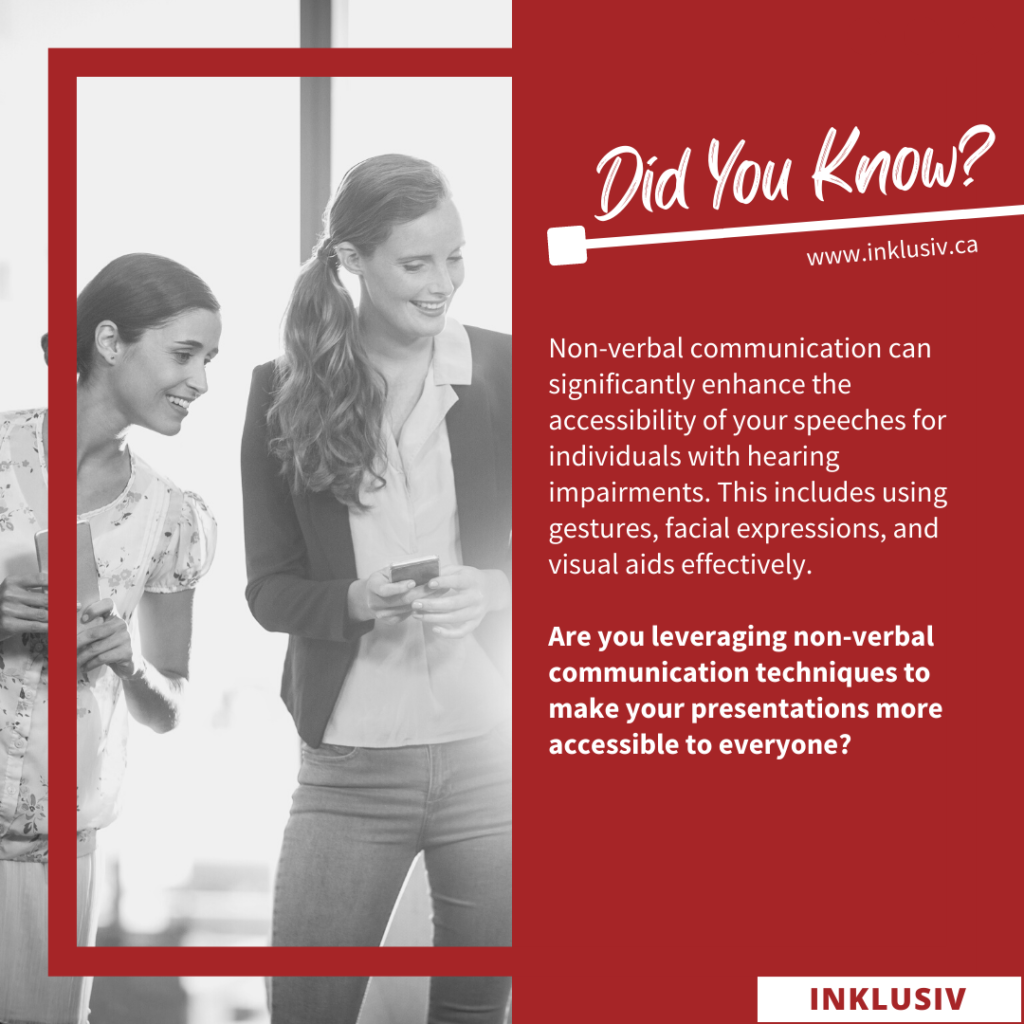

Non-verbal communication can significantly enhance the accessibility of your speeches for individuals with hearing impairments. This includes using gestures, facial expressions, and visual aids effectively. Are you leveraging non-verbal communication techniques to make your presentations more accessible to everyone?
More details about Did You Know… #097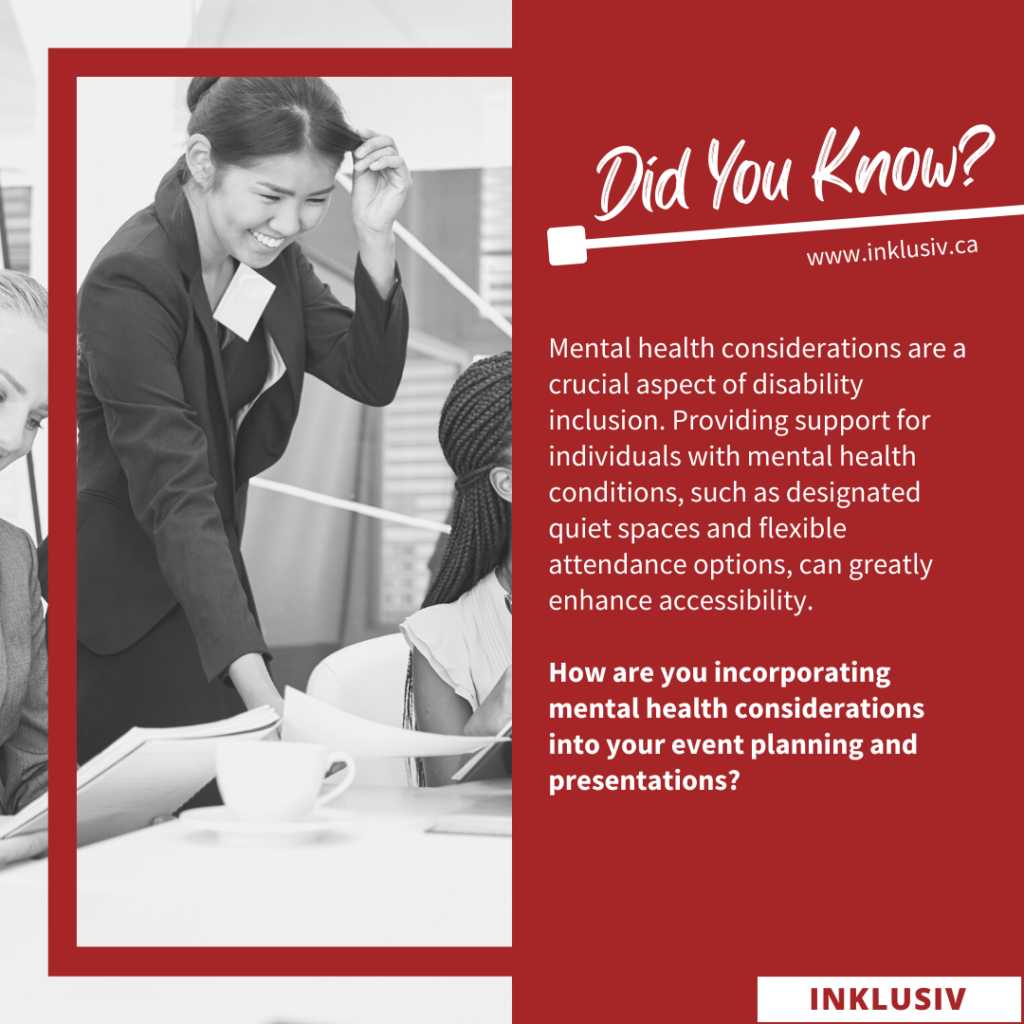

Mental health considerations are a crucial aspect of disability inclusion. Providing support for individuals with mental health conditions, such as designated quiet spaces and flexible attendance options, can greatly enhance accessibility. How are you incorporating mental health considerations into your event planning and presentations?
More details about Did You Know… #096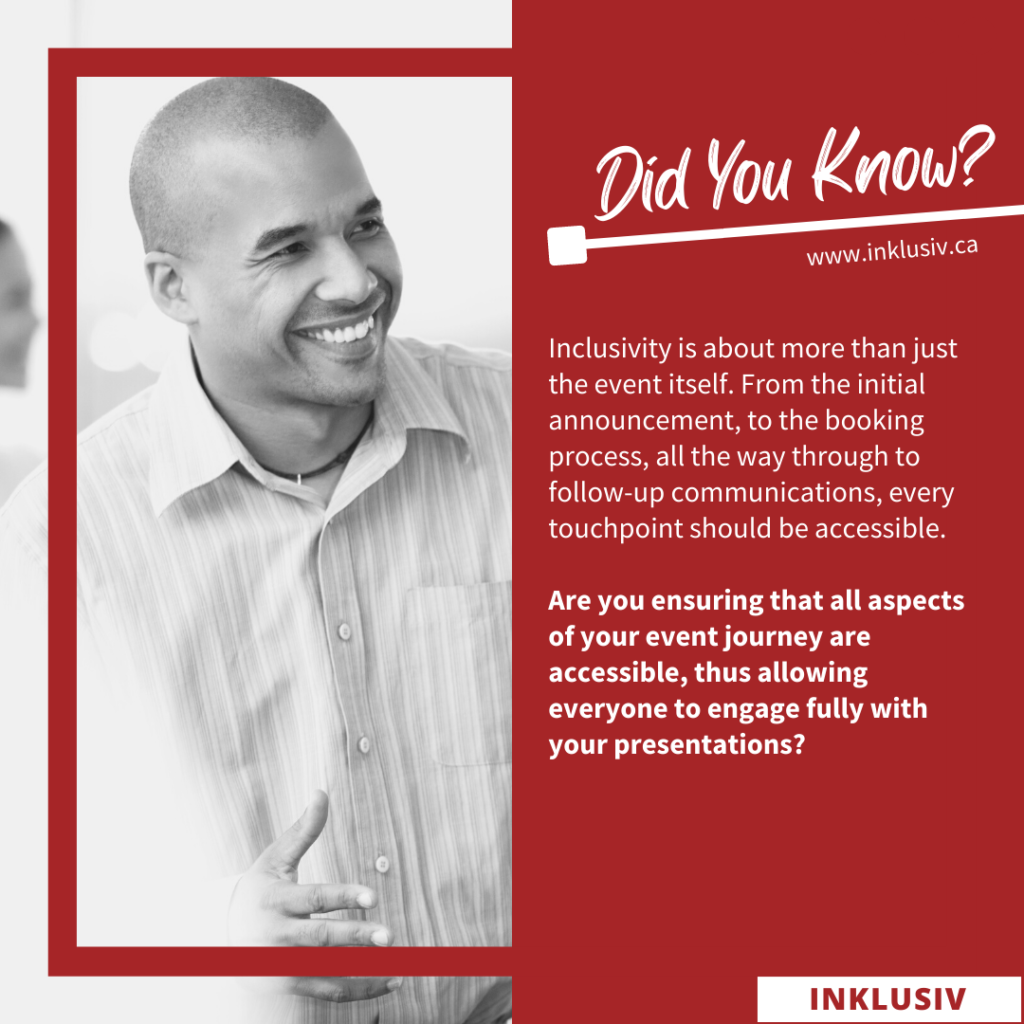

Inclusivity is about more than just the event itself. From the initial announcement, to the booking process, all the way through to follow-up communications, every touchpoint should be accessible. Are you ensuring that all aspects of your event journey are accessible, thus allowing everyone to engage fully with your presentations?
More details about Did You Know… #095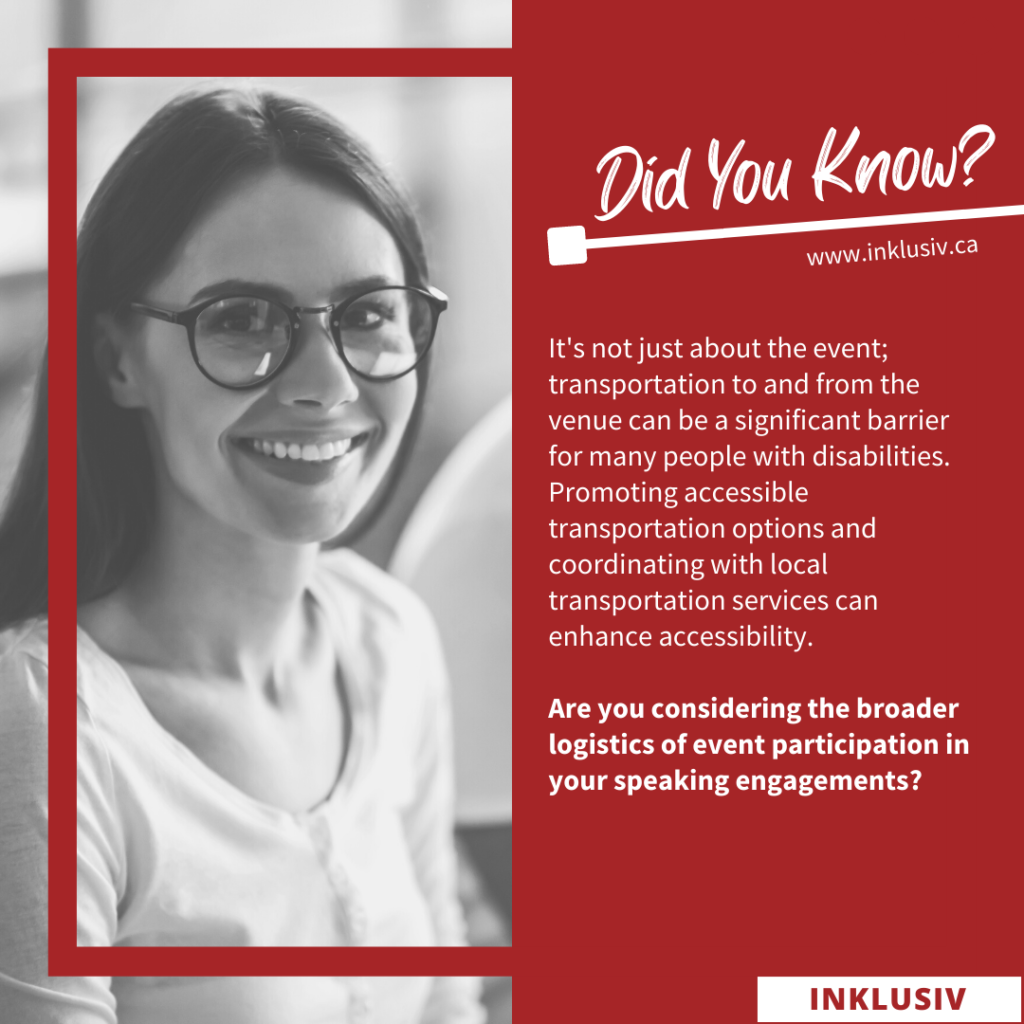

It’s not just about the event; transportation to and from the venue can be a significant barrier for many people with disabilities. Promoting accessible transportation options and coordinating with local transportation services can enhance accessibility. Are you considering the broader logistics of event participation in your speaking engagements?
More details about Did You Know… #094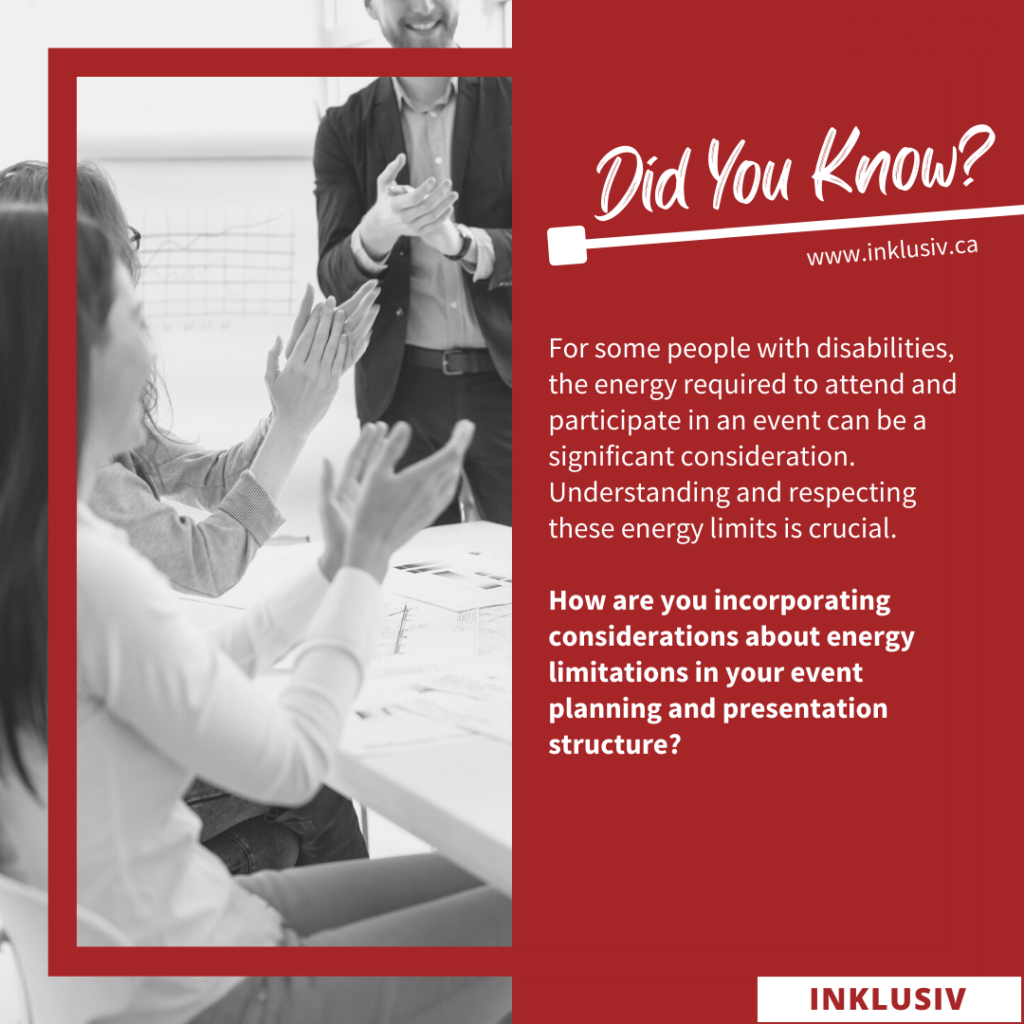

For some people with disabilities, the energy required to attend and participate in an event can be a significant consideration. Understanding and respecting these energy limits is crucial. How are you incorporating considerations about energy limitations in your event planning and presentation structure?
More details about Did You Know… #093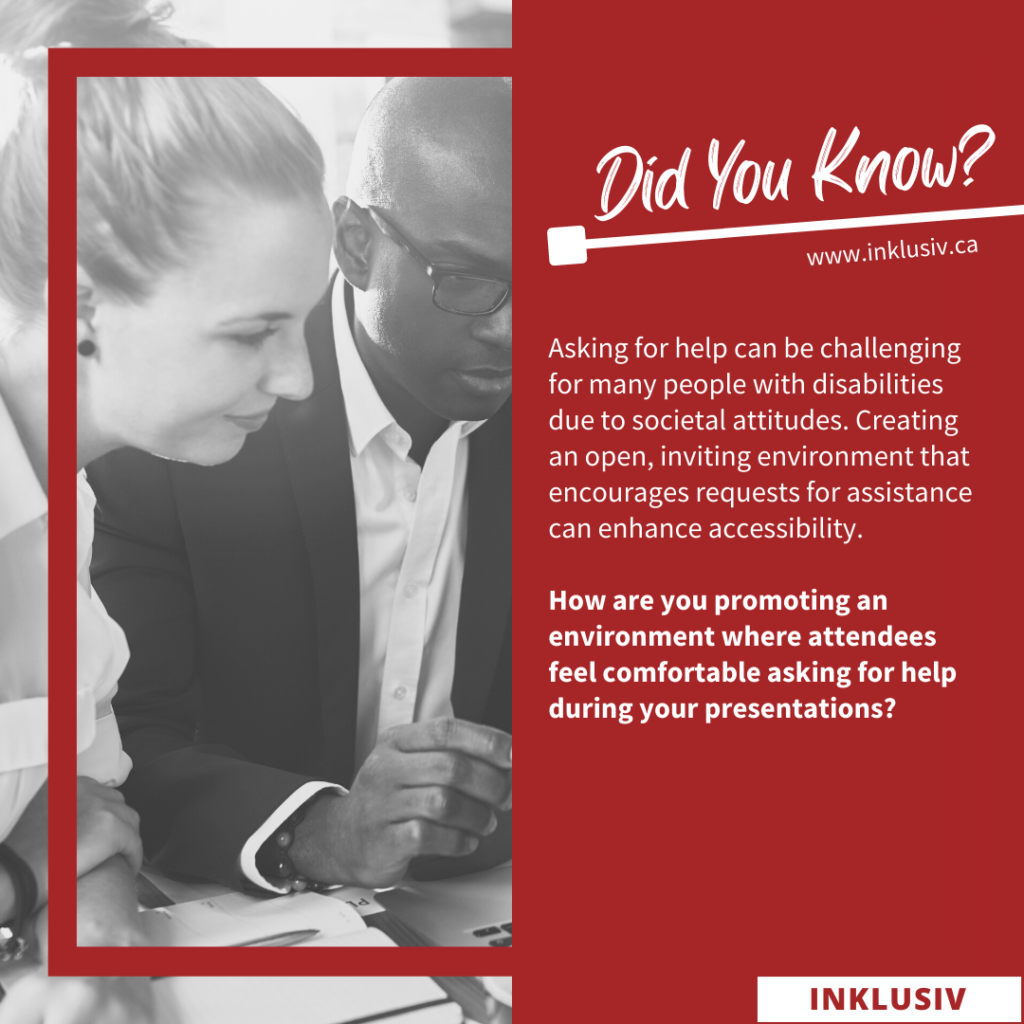

Asking for help can be challenging for many people with disabilities due to societal attitudes. Creating an open, inviting environment that encourages requests for assistance can enhance accessibility. How are you promoting an environment where attendees feel comfortable asking for help during your presentations?
More details about Did You Know… #092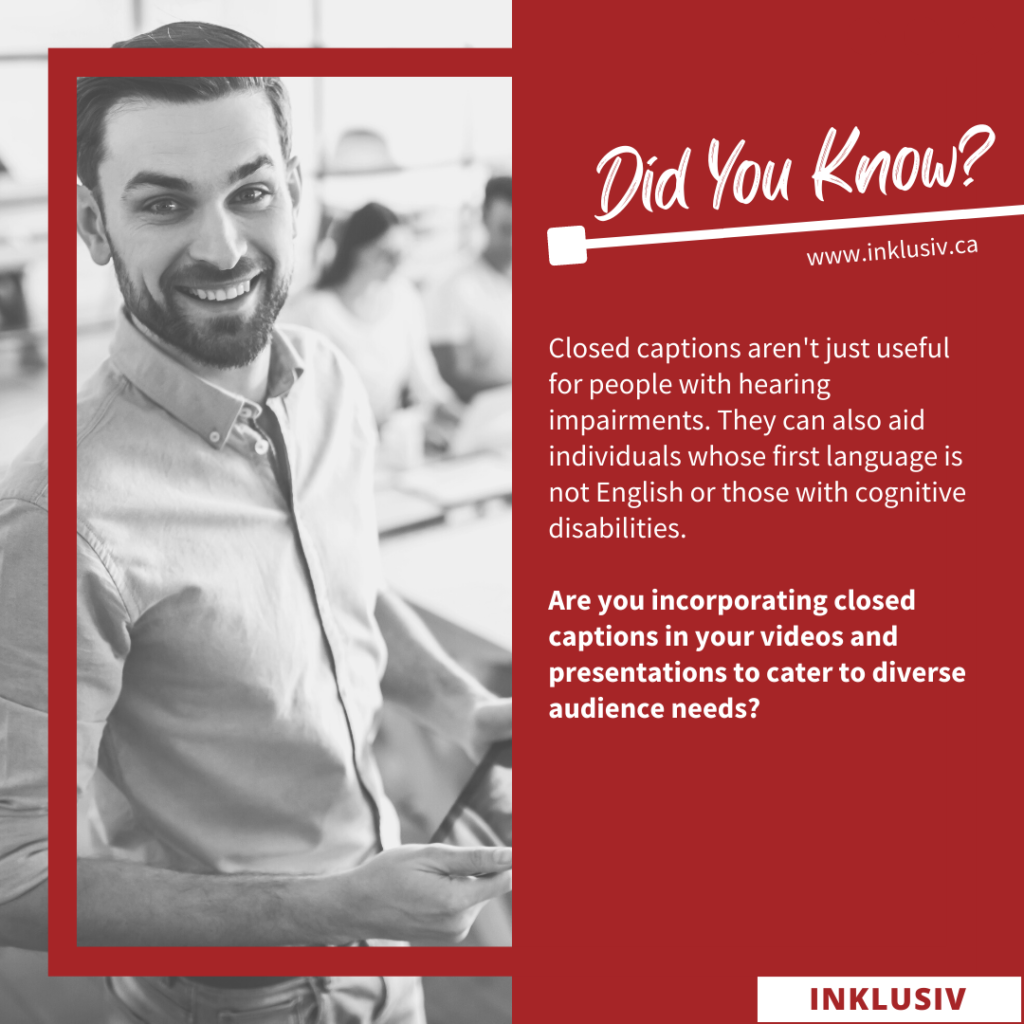

Closed captions aren’t just useful for people with hearing impairments. They can also aid individuals whose first language is not English or those with cognitive disabilities. Are you incorporating closed captions in your videos and presentations to cater to diverse audience needs?
More details about Did You Know… #091

True inclusivity recognizes the intersectionality of identities. Disability intersects with other identities such as race, gender, and sexual orientation, affecting people’s experiences. How are you considering this intersectionality in your speeches and presentations to ensure a truly inclusive environment?
More details about Did You Know… #090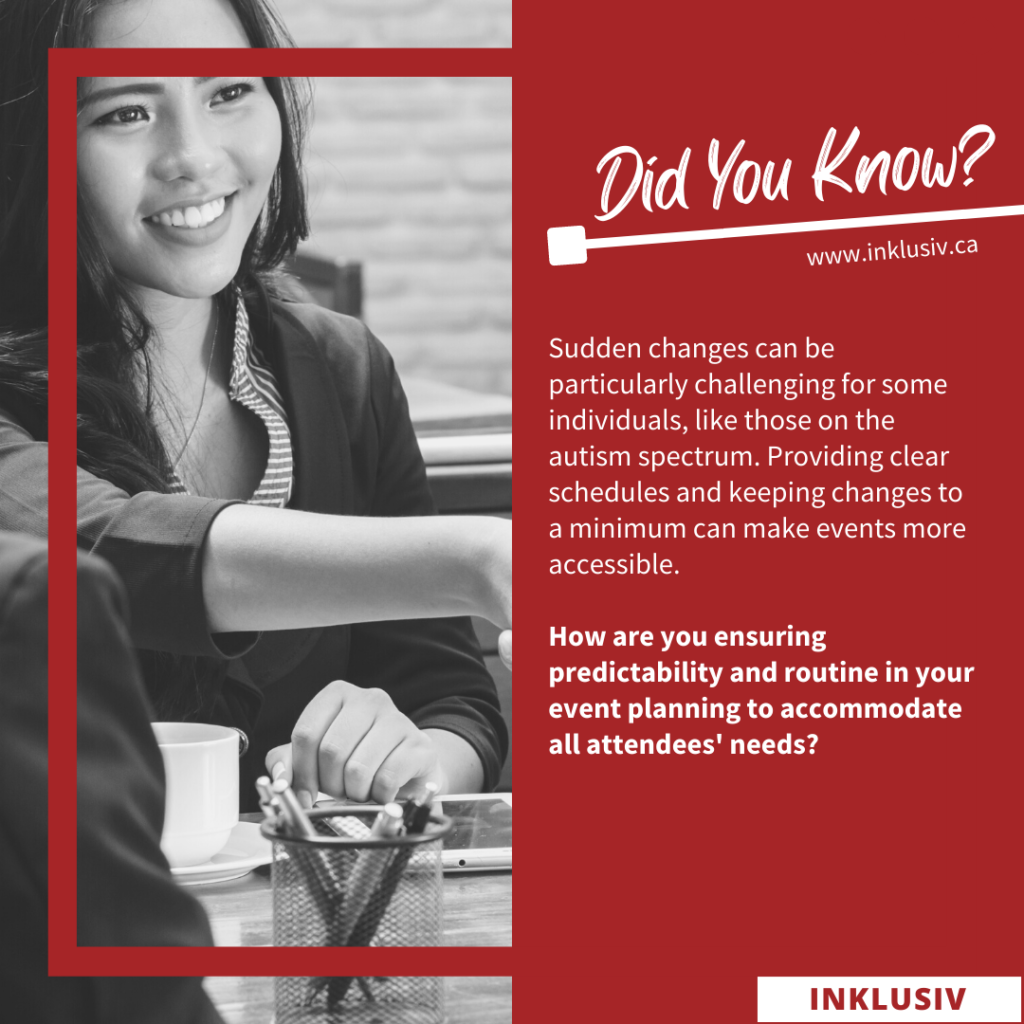

Sudden changes can be particularly challenging for some individuals, like those on the autism spectrum. Providing clear schedules and keeping changes to a minimum can make events more accessible. How are you ensuring predictability and routine in your event planning to accommodate all attendees’ needs?
More details about Did You Know… #089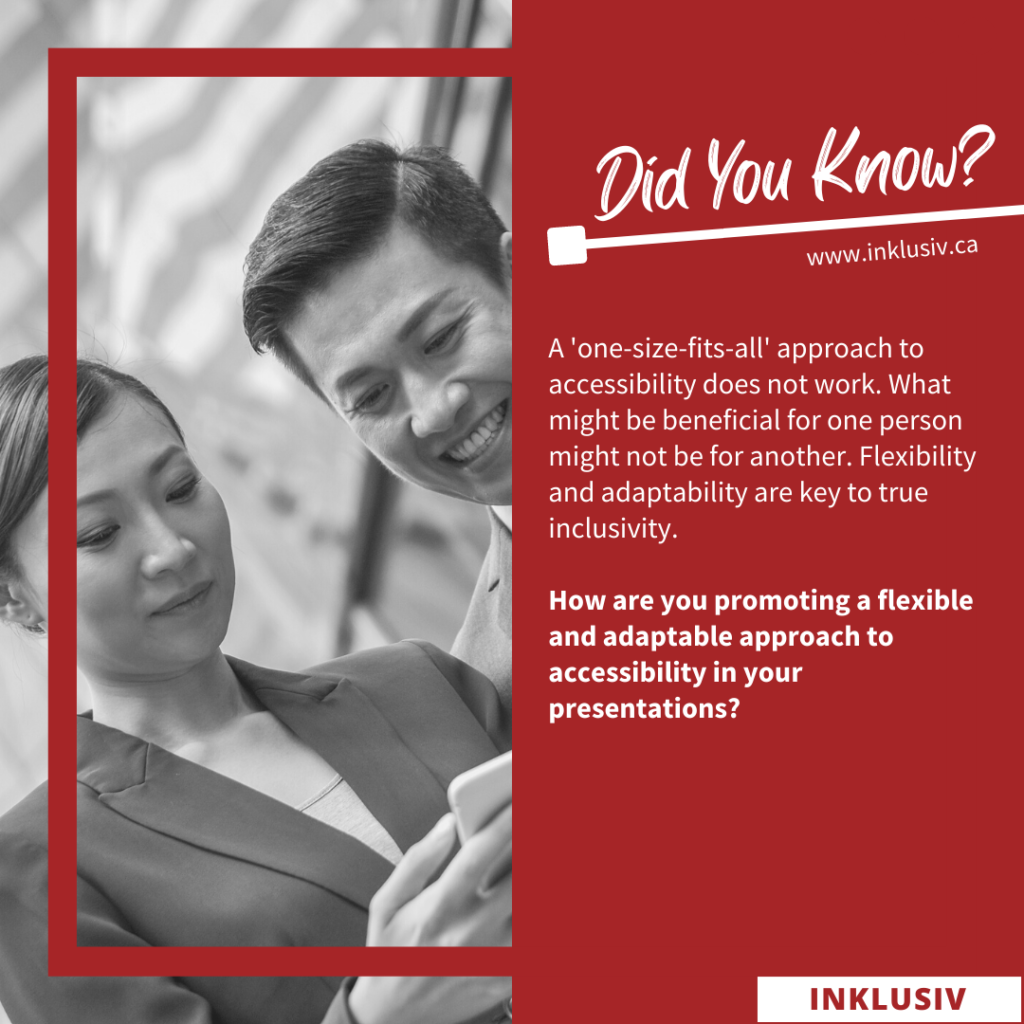

A ‘one-size-fits-all’ approach to accessibility does not work. What might be beneficial for one person might not be for another. Flexibility and adaptability are key to true inclusivity. How are you promoting a flexible and adaptable approach to accessibility in your presentations?
More details about Did You Know… #088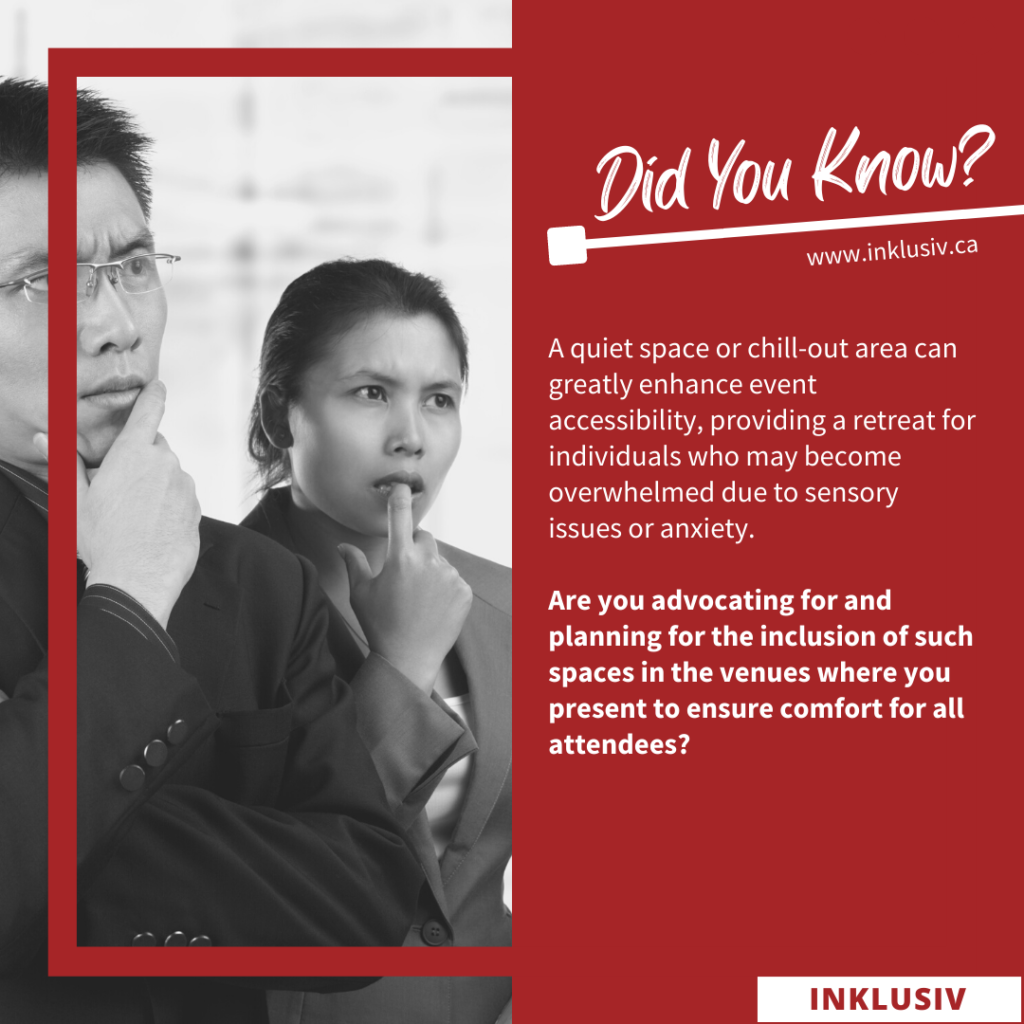

A quiet space or chill-out area can greatly enhance event accessibility, providing a retreat for individuals who may become overwhelmed due to sensory issues or anxiety. Are you advocating for and planning for the inclusion of such spaces in the venues where you present to ensure comfort for all attendees?
More details about Did You Know… #087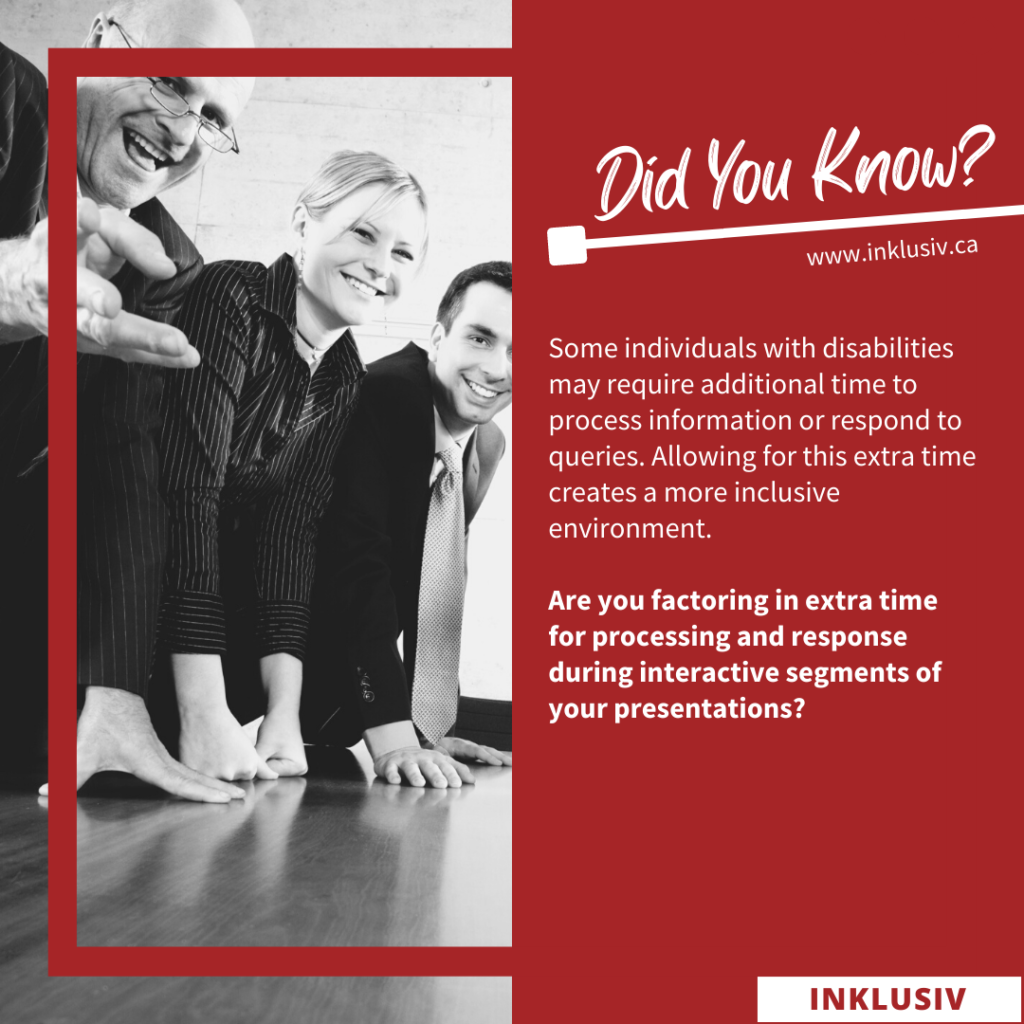

Some individuals with disabilities may require additional time to process information or respond to queries. Allowing for this extra time creates a more inclusive environment. Are you factoring in extra time for processing and response during interactive segments of your presentations?
More details about Did You Know… #086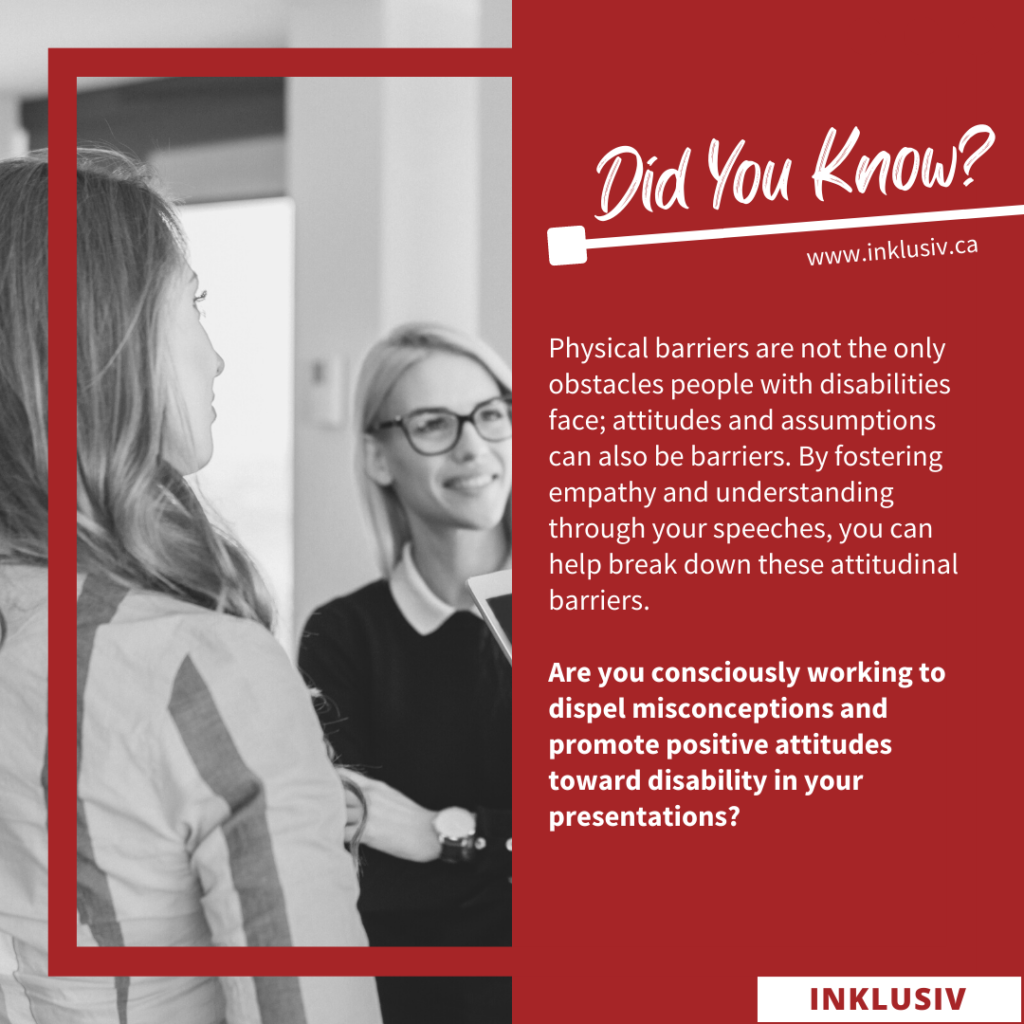

Physical barriers are not the only obstacles people with disabilities face; attitudes and assumptions can also be barriers. By fostering empathy and understanding through your speeches, you can help break down these attitudinal barriers. Are you consciously working to dispel misconceptions and promote positive attitudes toward disability in your presentations?
More details about Did You Know… #085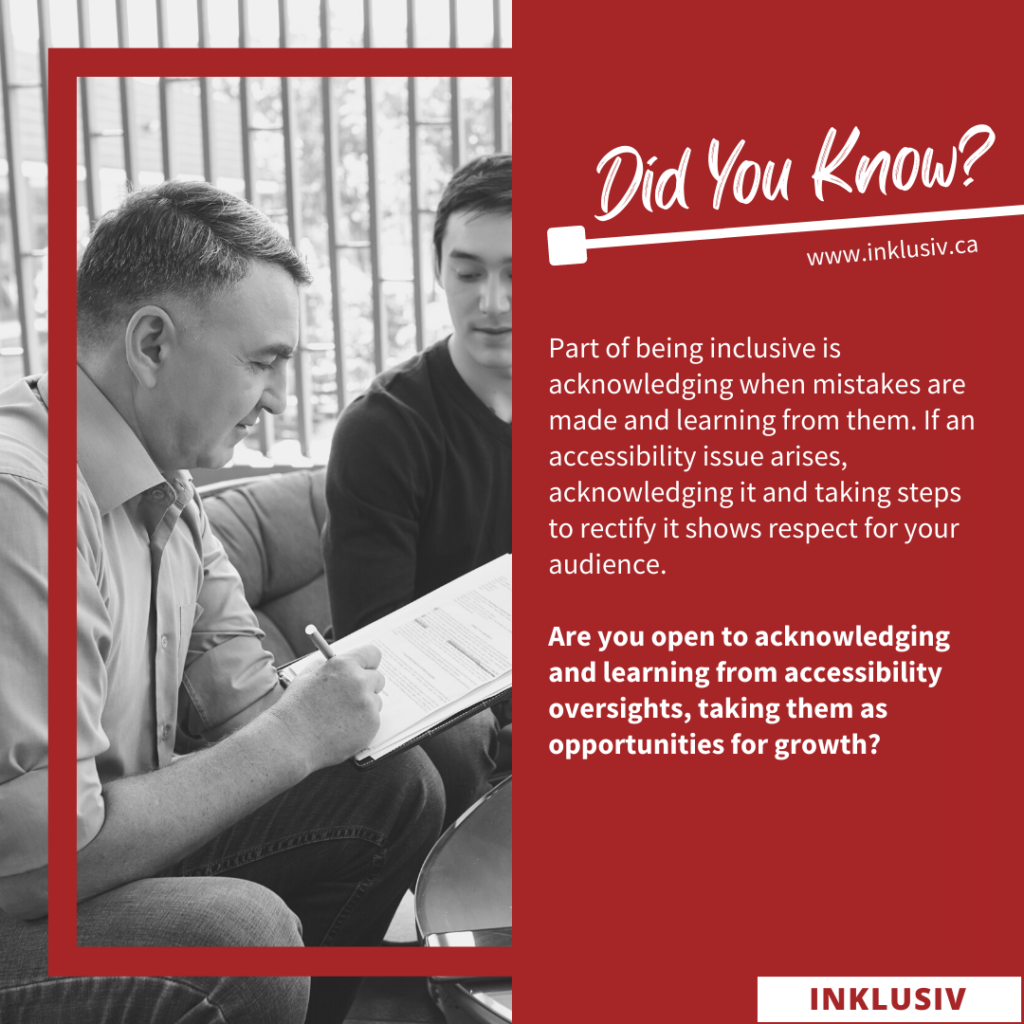

Part of being inclusive is acknowledging when mistakes are made and learning from them. If an accessibility issue arises, acknowledging it and taking steps to rectify it shows respect for your audience. Are you open to acknowledging and learning from accessibility oversights, taking them as opportunities for growth?
More details about Did You Know… #084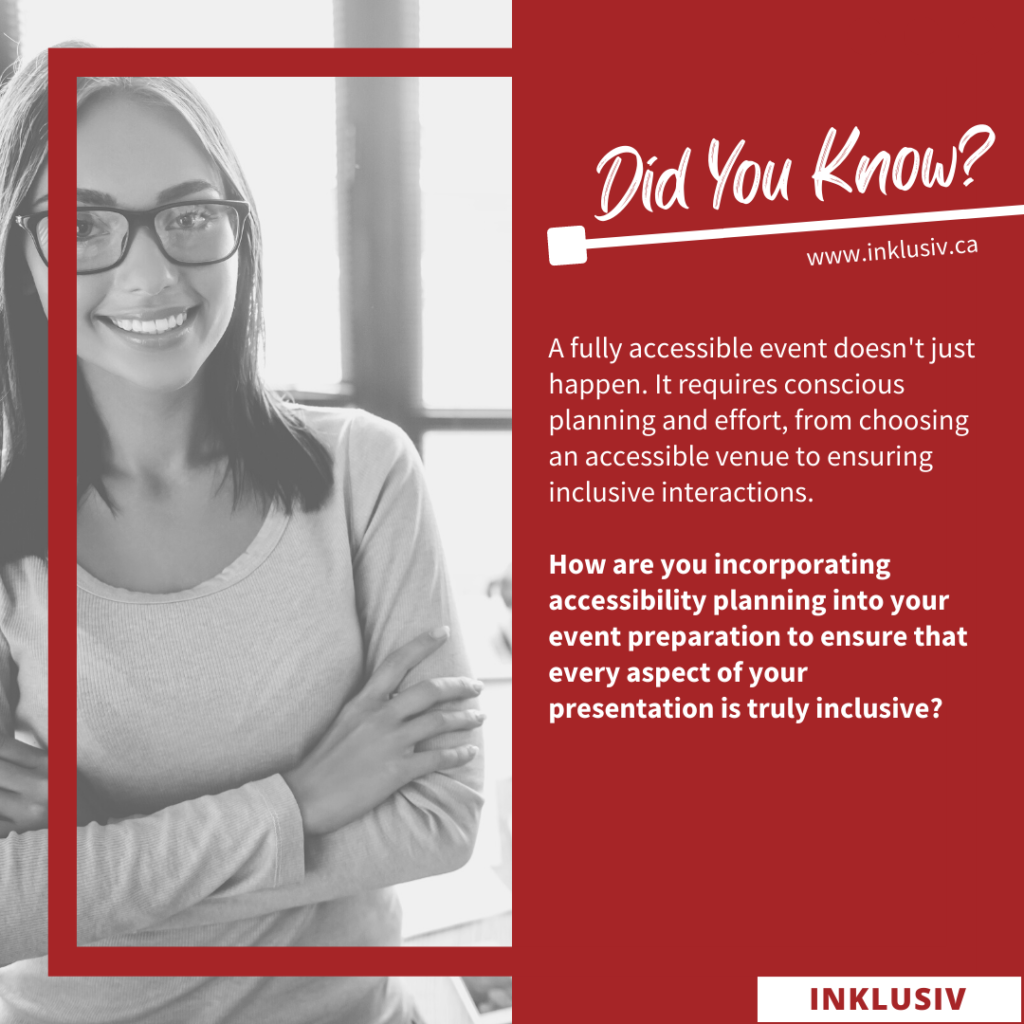

A fully accessible event doesn’t just happen. It requires conscious planning and effort, from choosing an accessible venue to ensuring inclusive interactions. How are you incorporating accessibility planning into your event preparation to ensure that every aspect of your presentation is truly inclusive?
More details about Did You Know… #083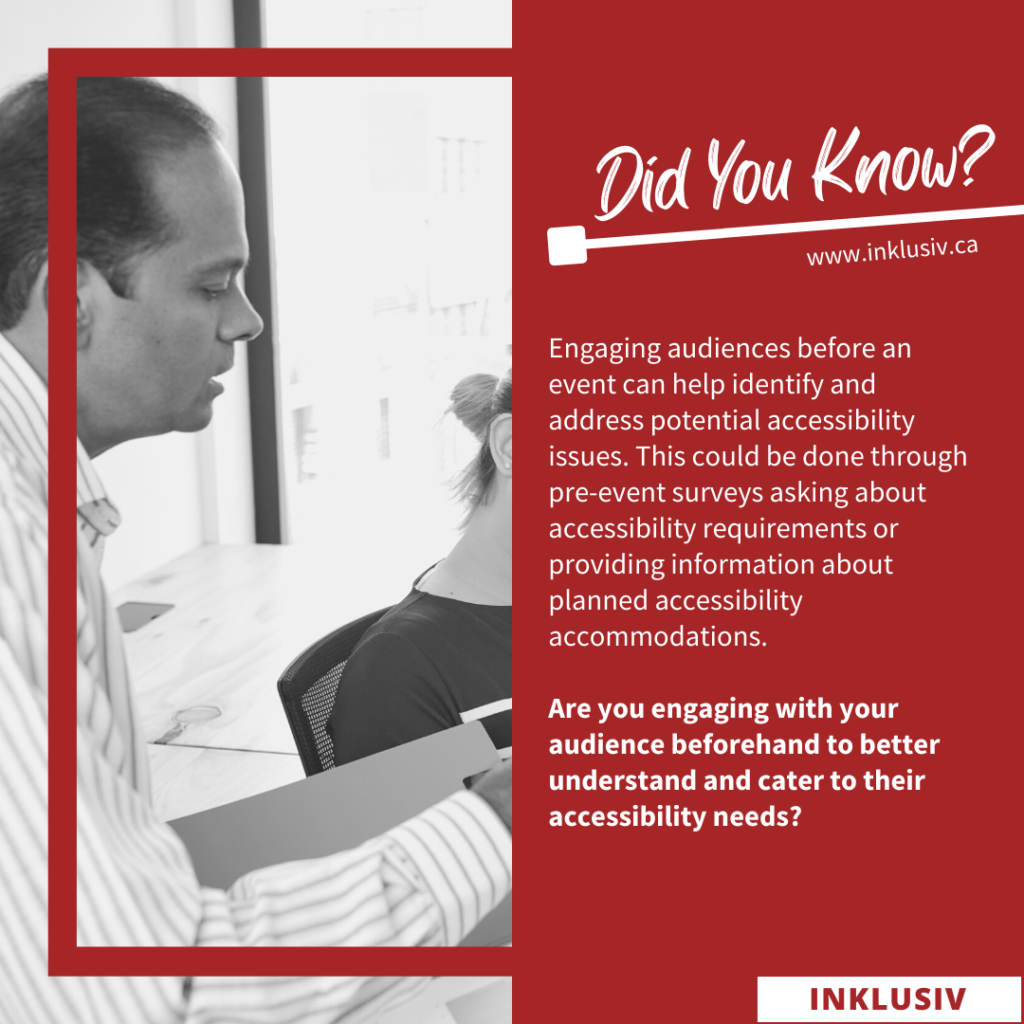

Engaging audiences before an event can help identify and address potential accessibility issues. This could be done through pre-event surveys asking about accessibility requirements or providing information about planned accessibility accommodations. Are you engaging with your audience beforehand to better understand and cater to their accessibility needs?
More details about Did You Know… #082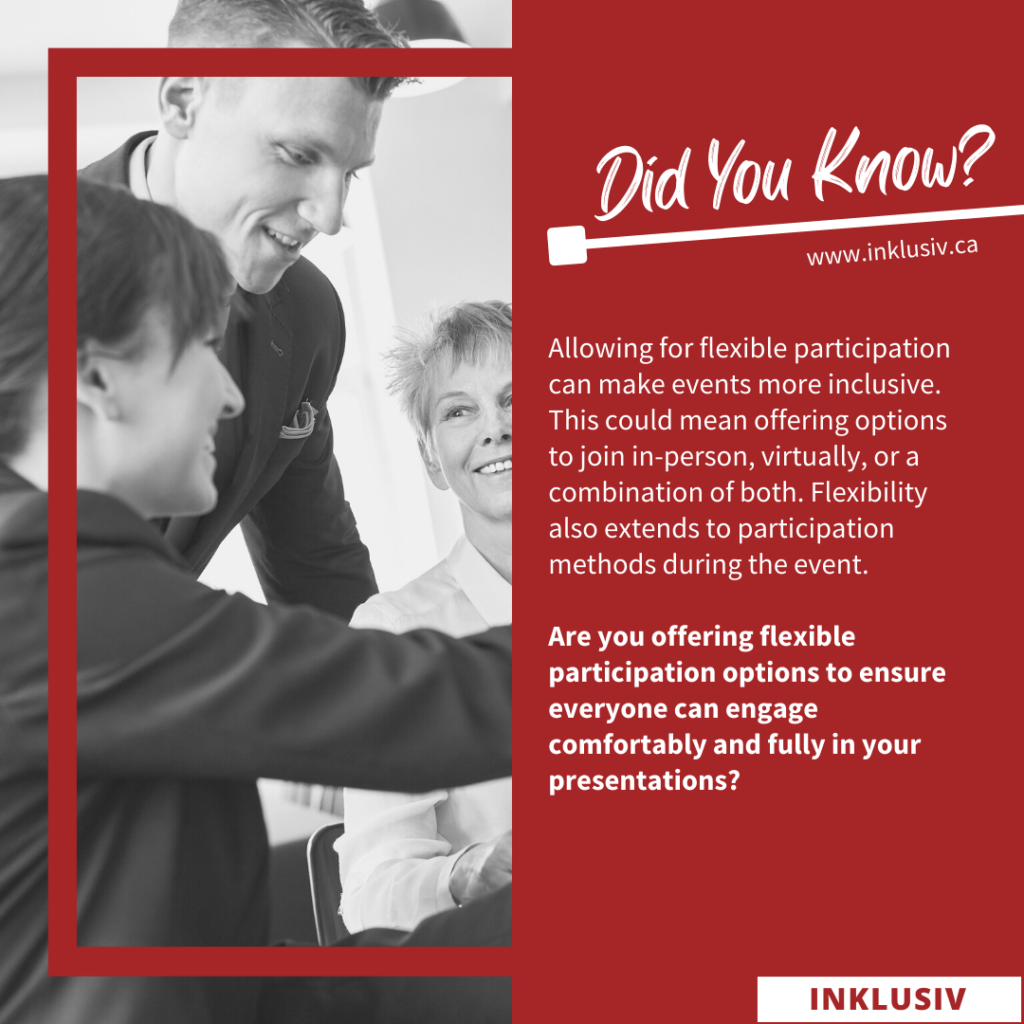

Allowing for flexible participation can make events more inclusive. This could mean offering options to join in-person, virtually, or a combination of both. Flexibility also extends to participation methods during the event. Are you offering flexible participation options to ensure everyone can engage comfortably and fully in your presentations?
More details about Did You Know… #081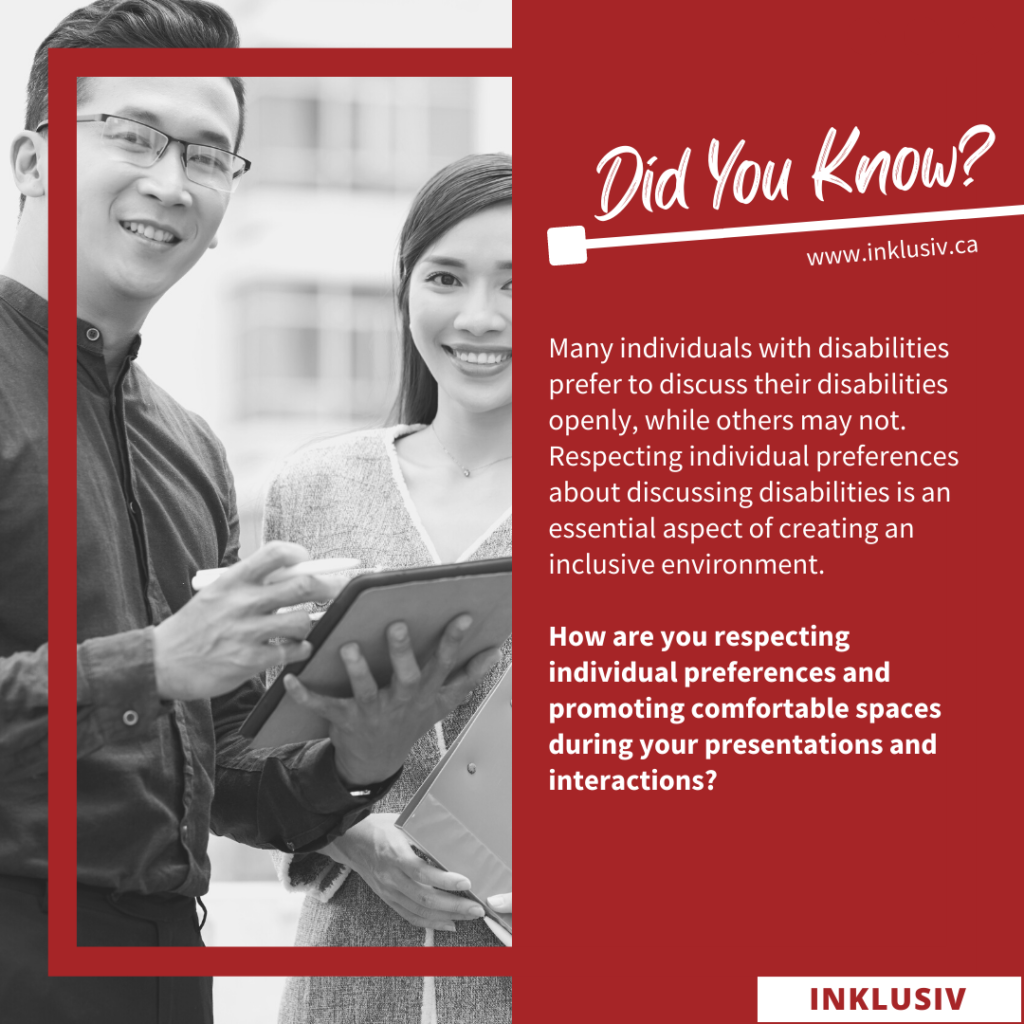

Many individuals with disabilities prefer to discuss their disabilities openly, while others may not. Respecting individual preferences about discussing disabilities is an essential aspect of creating an inclusive environment. How are you respecting individual preferences and promoting comfortable spaces during your presentations and interactions?
More details about Did You Know… #080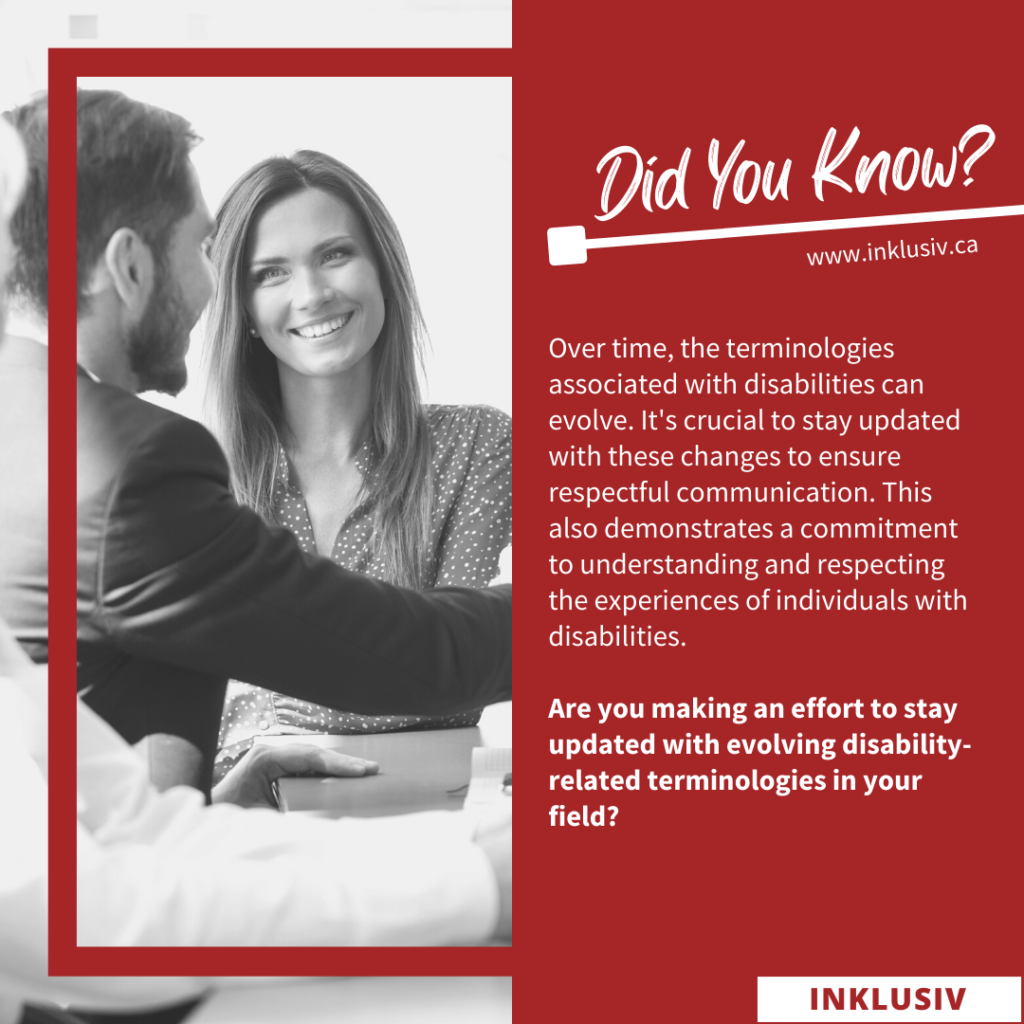

Over time, the terminologies associated with disabilities can evolve. It’s crucial to stay updated with these changes to ensure respectful communication. This also demonstrates a commitment to understanding and respecting the experiences of individuals with disabilities. Are you making an effort to stay updated with evolving disability-related terminologies in your field?
More details about Did You Know… #079

Inclusive language isn’t just about avoiding offensive terms. It also involves the conscious use of words that reflect respect for people’s identity. People-first language, emphasizing the person before the disability, is generally preferred. Are you mindful of employing people-first language in your speeches to foster respect and inclusivity?
More details about Did You Know… #078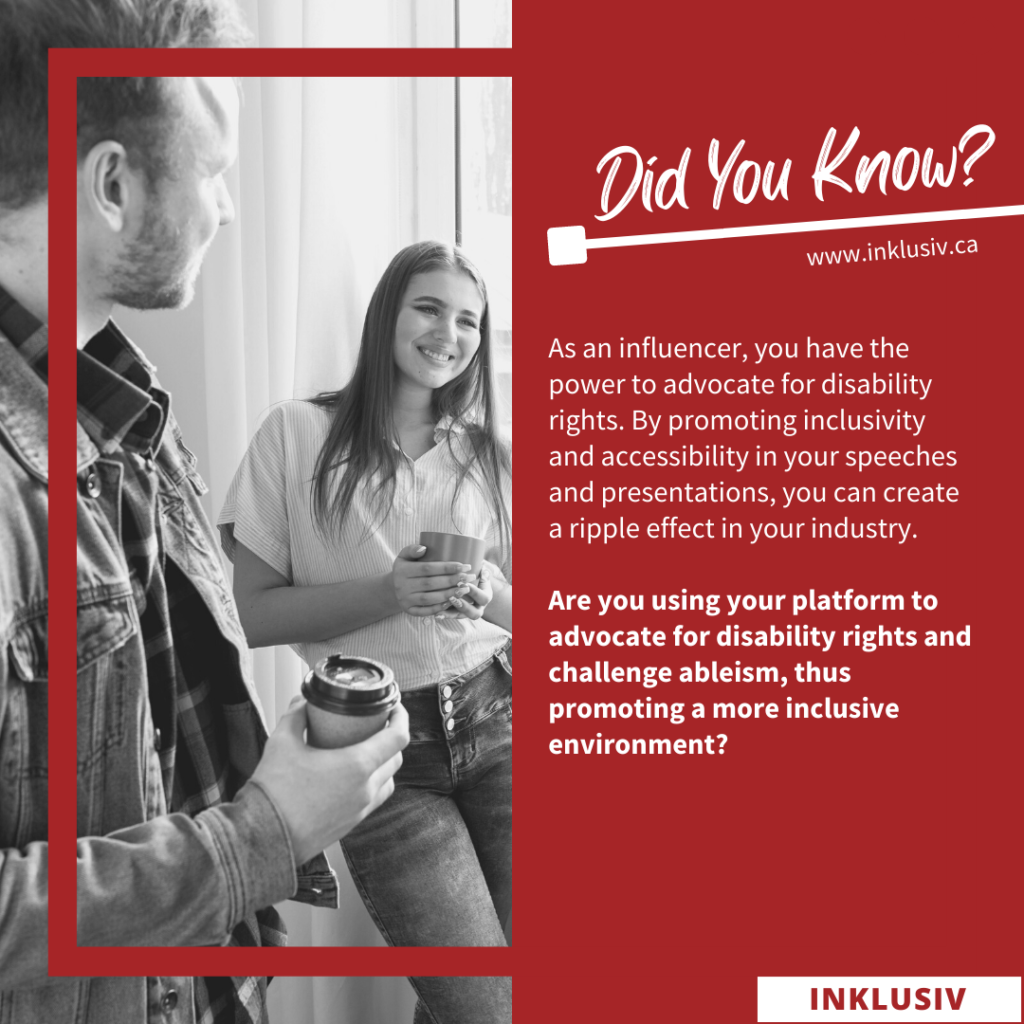

As an influencer, you have the power to advocate for disability rights. By promoting inclusivity and accessibility in your speeches and presentations, you can create a ripple effect in your industry. Are you using your platform to advocate for disability rights and challenge ableism, thus promoting a more inclusive environment?
More details about Did You Know… #077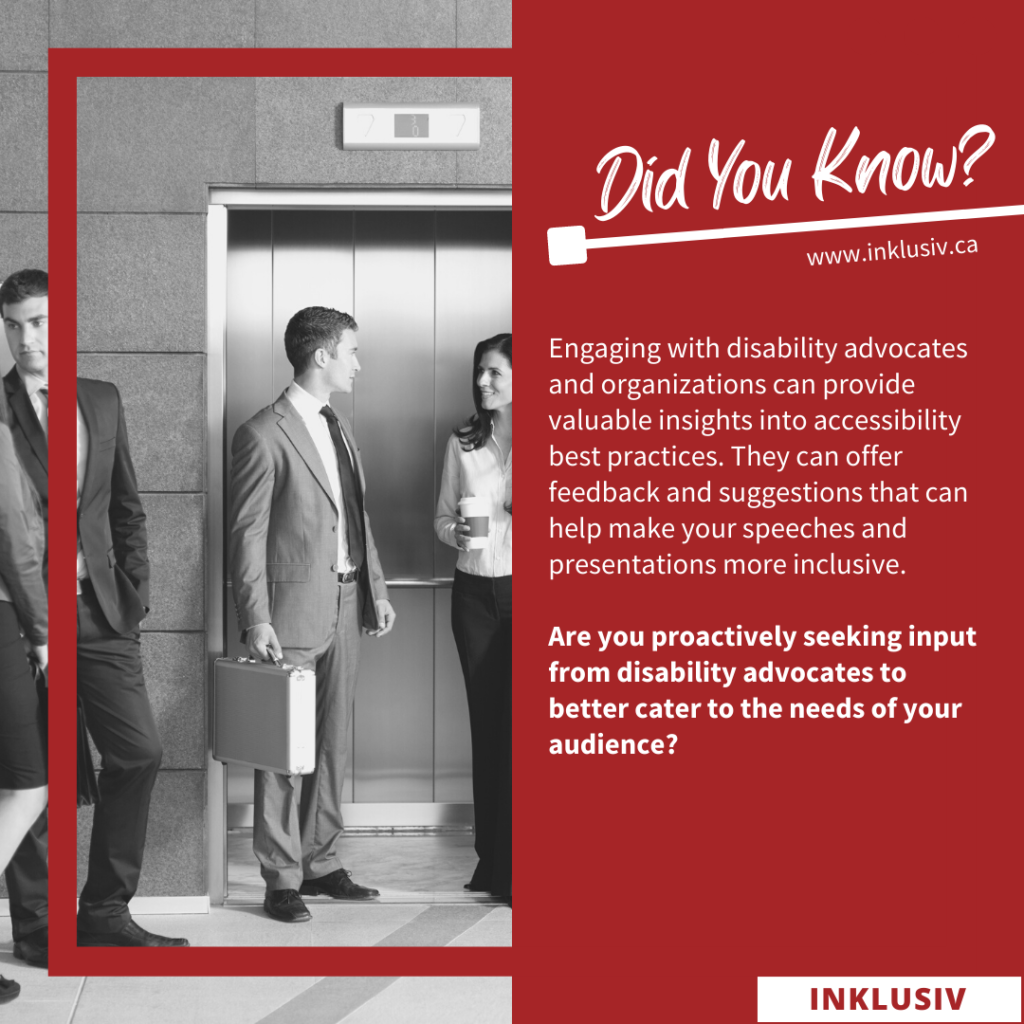

Engaging with disability advocates and organizations can provide valuable insights into accessibility best practices. They can offer feedback and suggestions that can help make your speeches and presentations more inclusive. Are you proactively seeking input from disability advocates to better cater to the needs of your audience?
More details about Did You Know… #076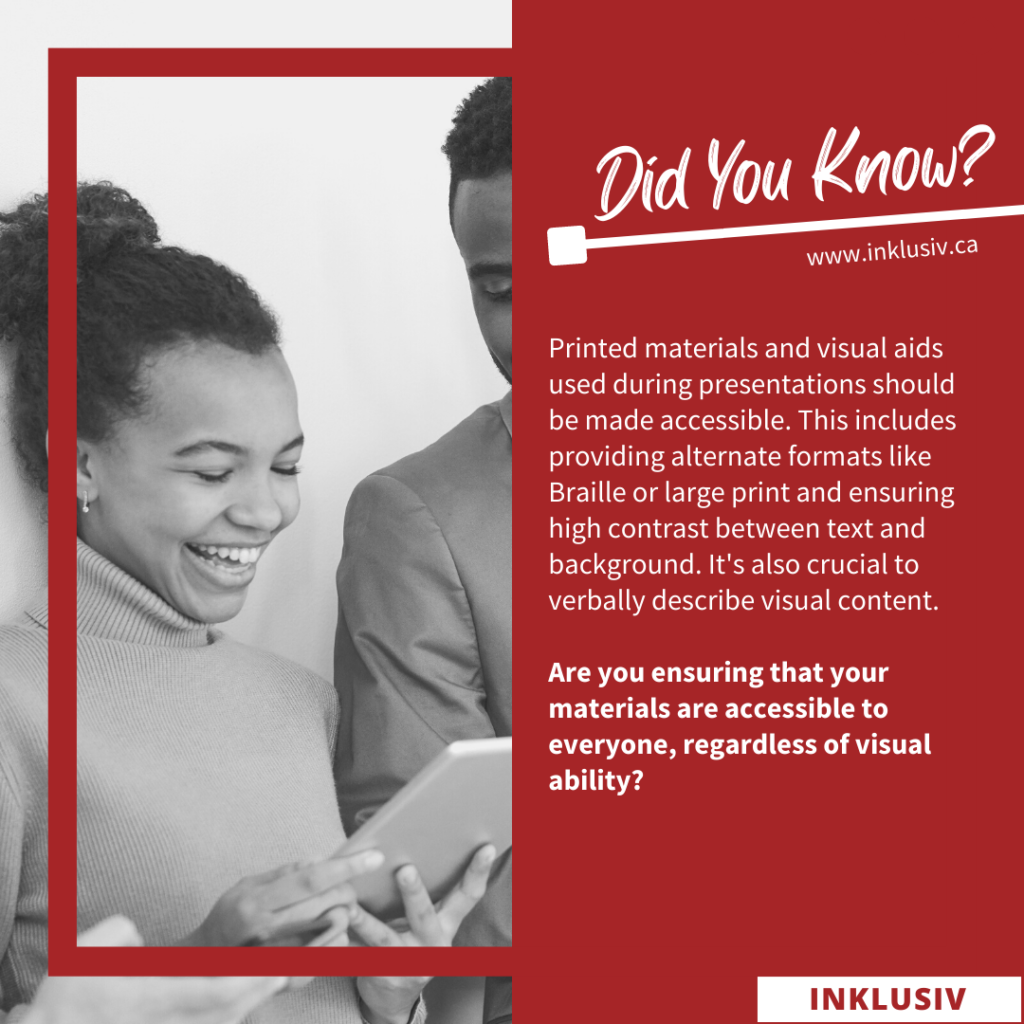

Printed materials and visual aids used during presentations should be made accessible. This includes providing alternate formats like Braille or large print and ensuring high contrast between text and background. It’s also crucial to verbally describe visual content. Are you ensuring that your materials are accessible to everyone, regardless of visual ability?
More details about Did You Know… #075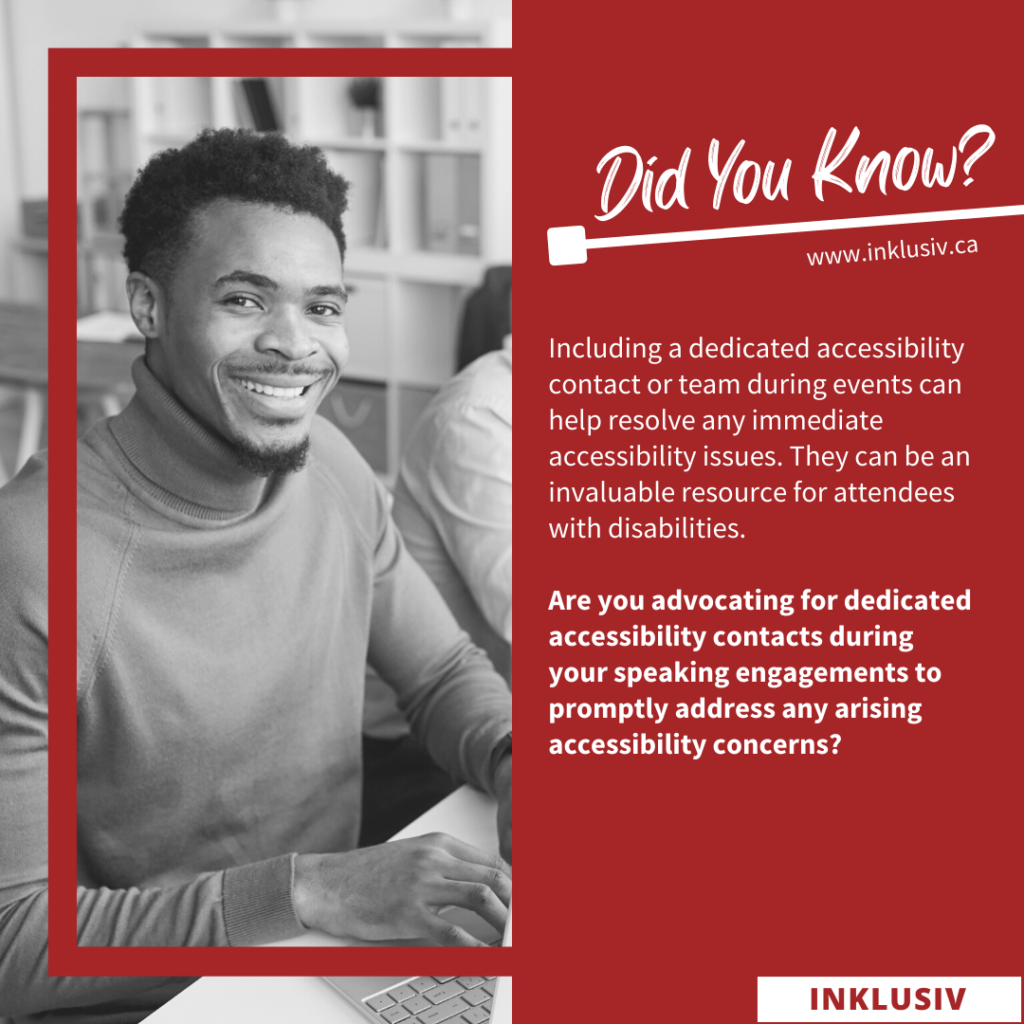

Including a dedicated accessibility contact or team during events can help resolve any immediate accessibility issues. They can be an invaluable resource for attendees with disabilities. Are you advocating for dedicated accessibility contacts during your speaking engagements to promptly address any arising accessibility concerns?
More details about Did You Know… #074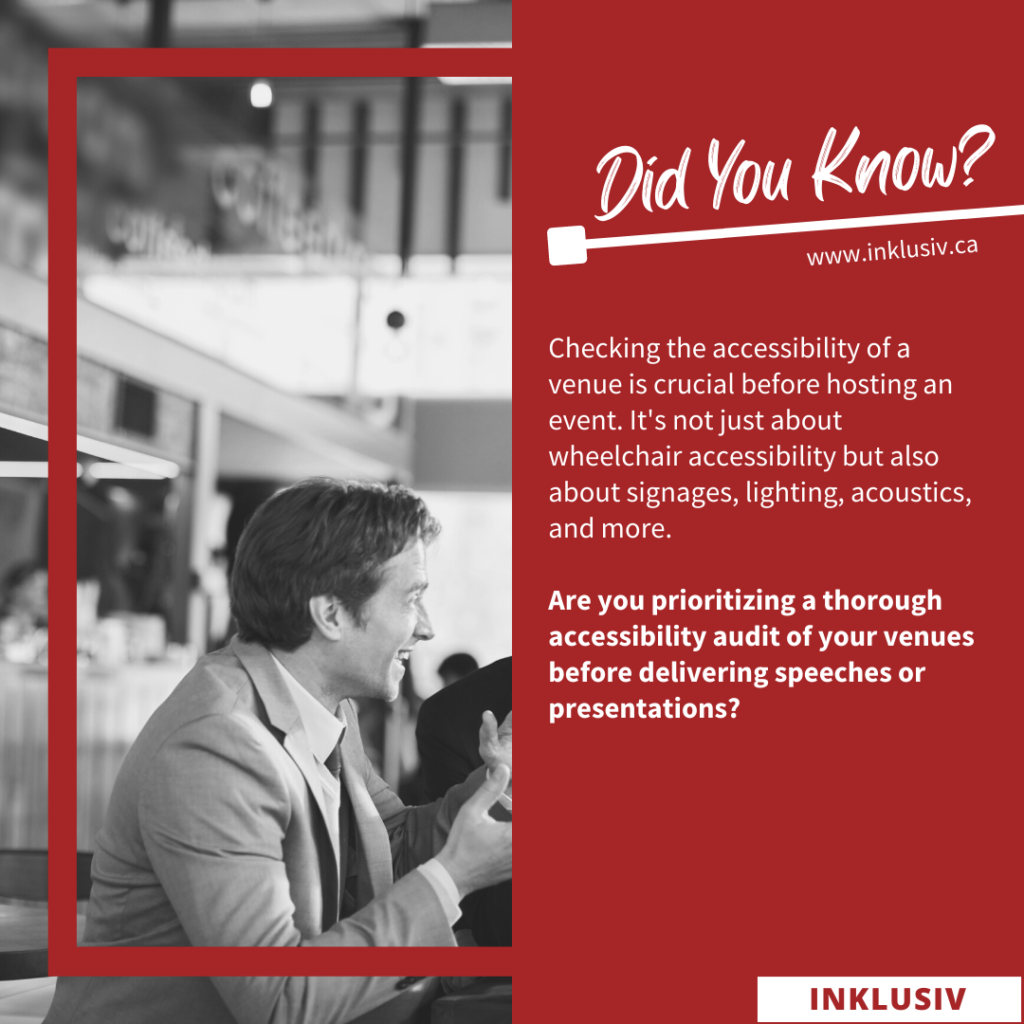

Checking the accessibility of a venue is crucial before hosting an event. It’s not just about wheelchair accessibility but also about signages, lighting, acoustics, and more. Are you prioritizing a thorough accessibility audit of your venues before delivering speeches or presentations?
More details about Did You Know… #073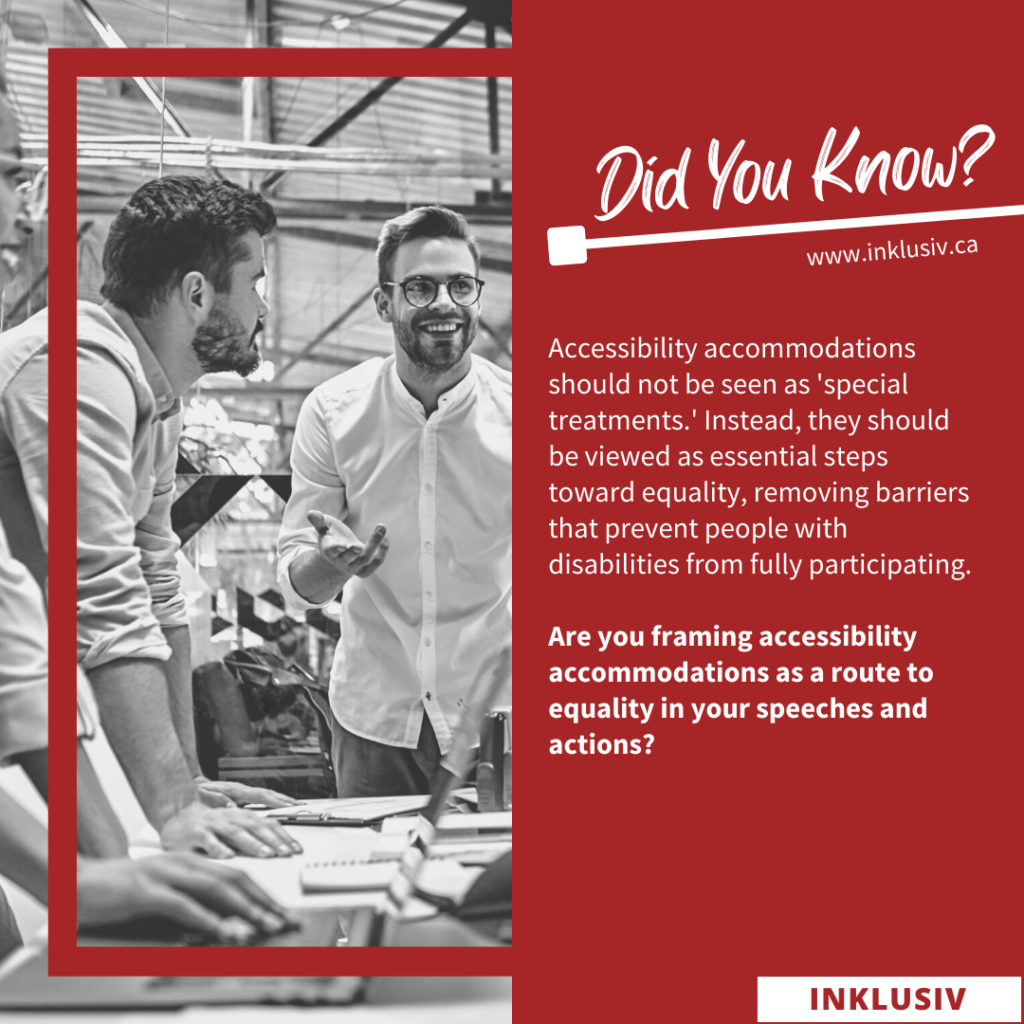

Accessibility accommodations should not be seen as ‘special treatments.’ Instead, they should be viewed as essential steps toward equality, removing barriers that prevent people with disabilities from fully participating. Are you framing accessibility accommodations as a route to equality in your speeches and actions?
More details about Did You Know… #072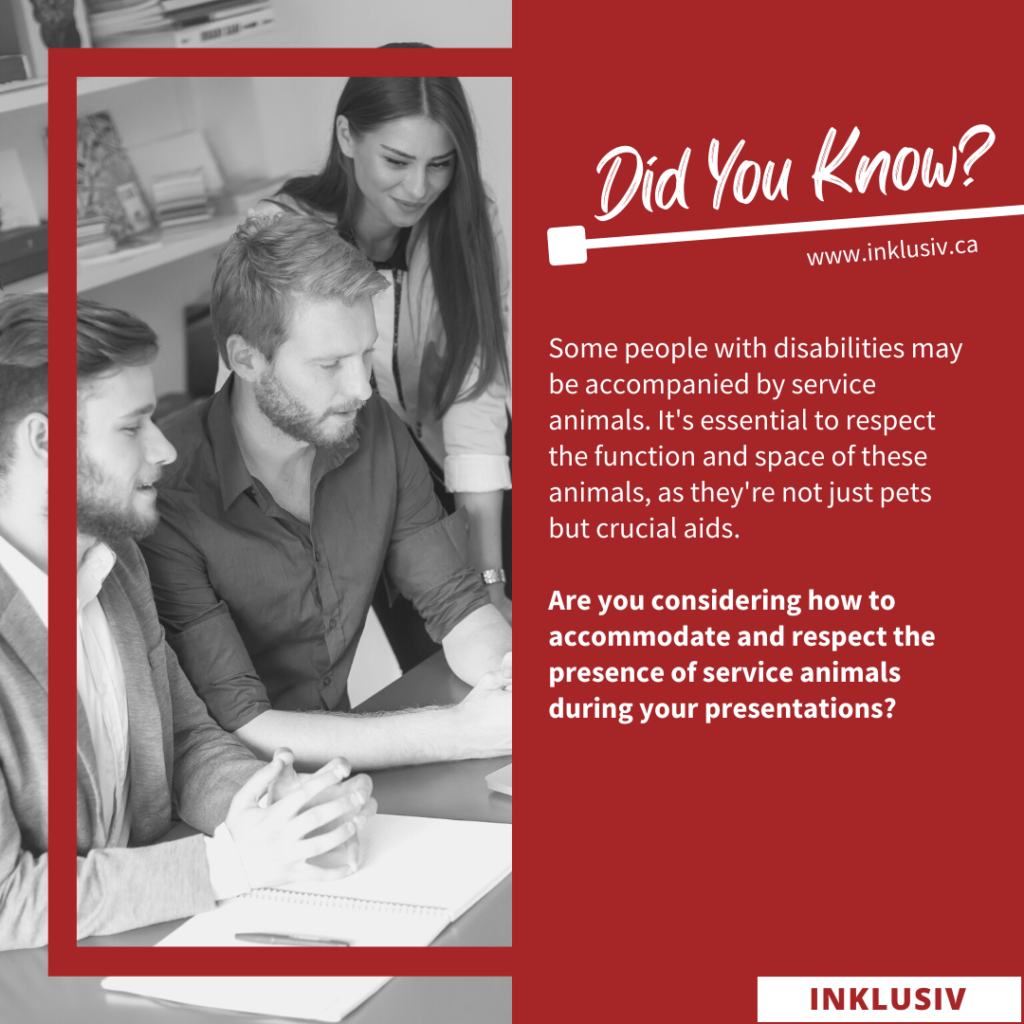

Some people with disabilities may be accompanied by service animals. It’s essential to respect the function and space of these animals, as they’re not just pets but crucial aids. Are you considering how to accommodate and respect the presence of service animals during your presentations?
More details about Did You Know… #071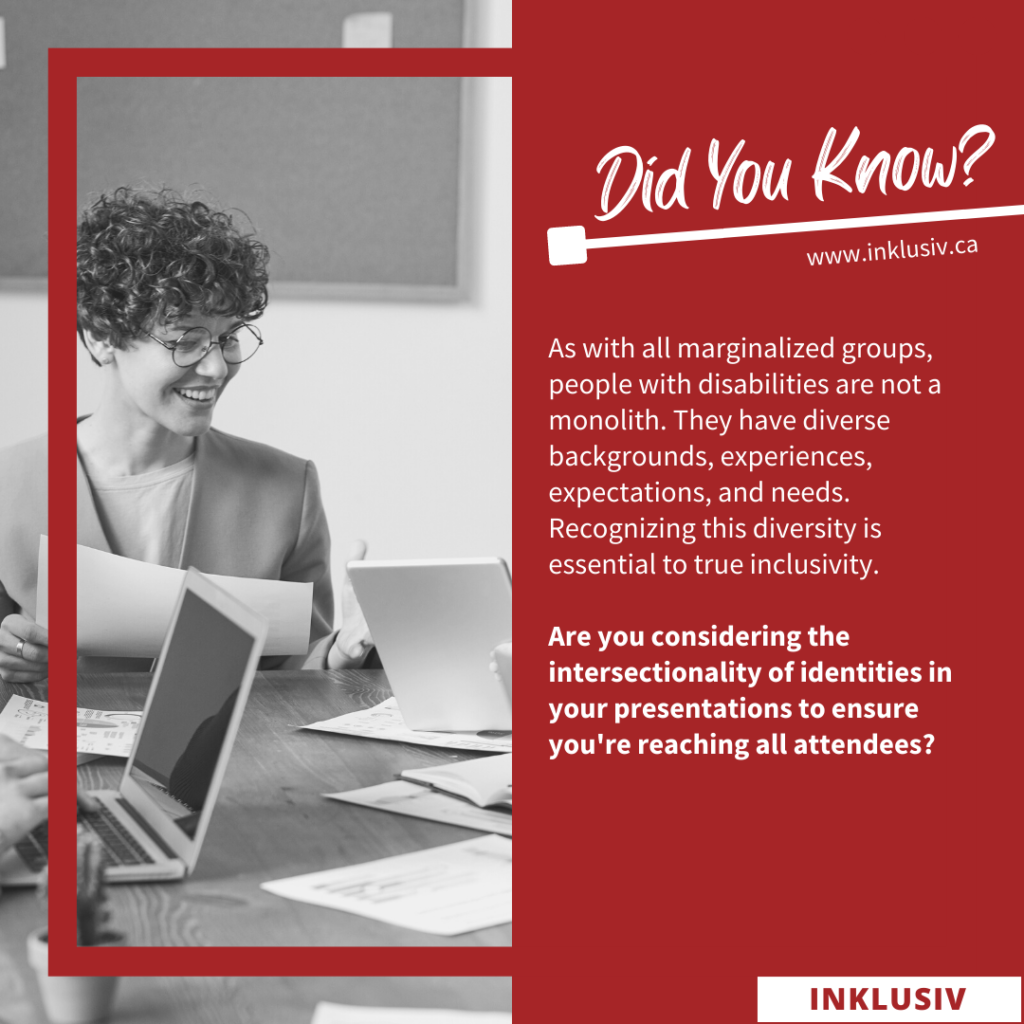

As with all marginalized groups, people with disabilities are not a monolith. They have diverse backgrounds, experiences, expectations, and needs. Recognizing this diversity is essential to true inclusivity. Are you considering the intersectionality of identities in your presentations to ensure you’re reaching all attendees?
More details about Did You Know… #070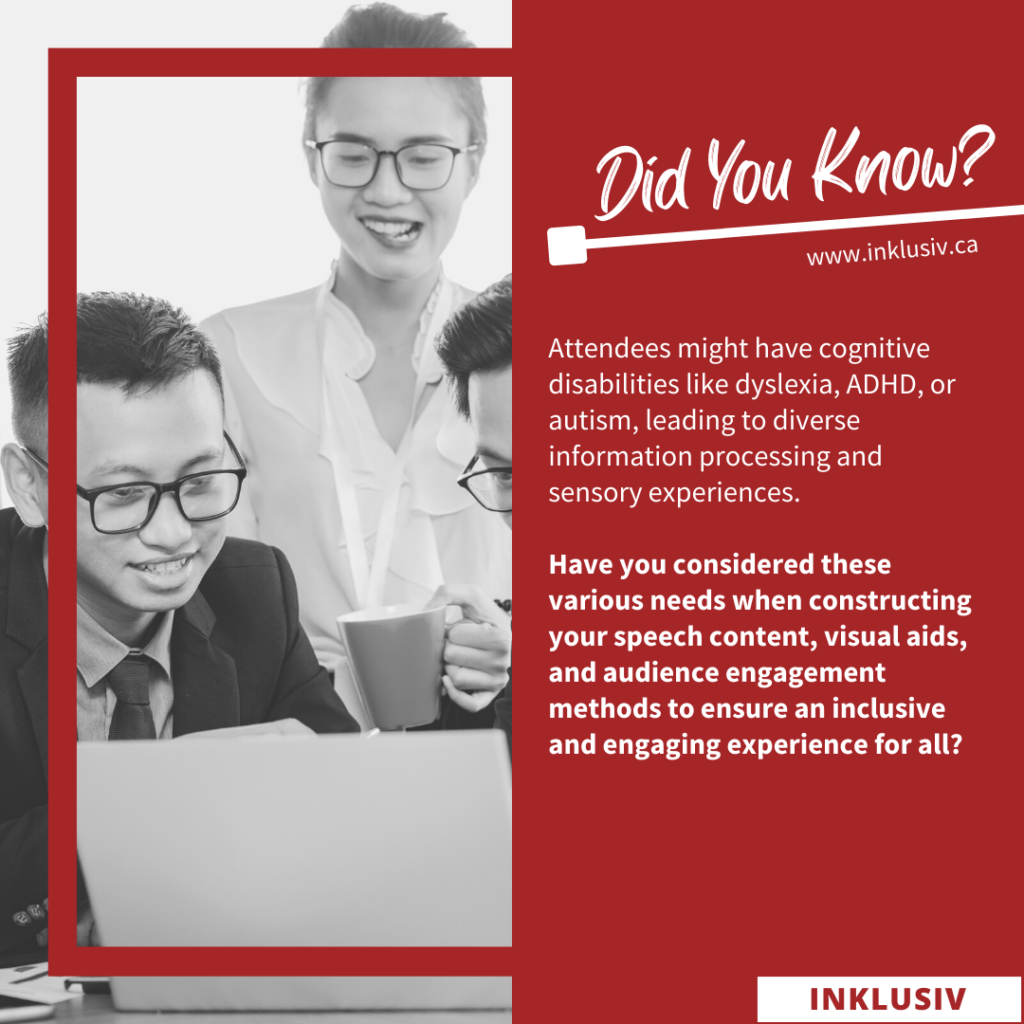

Attendees might have cognitive disabilities like dyslexia, ADHD, or autism, leading to diverse information processing and sensory experiences. Have you considered these various needs when constructing your speech content, visual aids, and audience engagement methods to ensure an inclusive and engaging experience for all?
More details about Did You Know… #069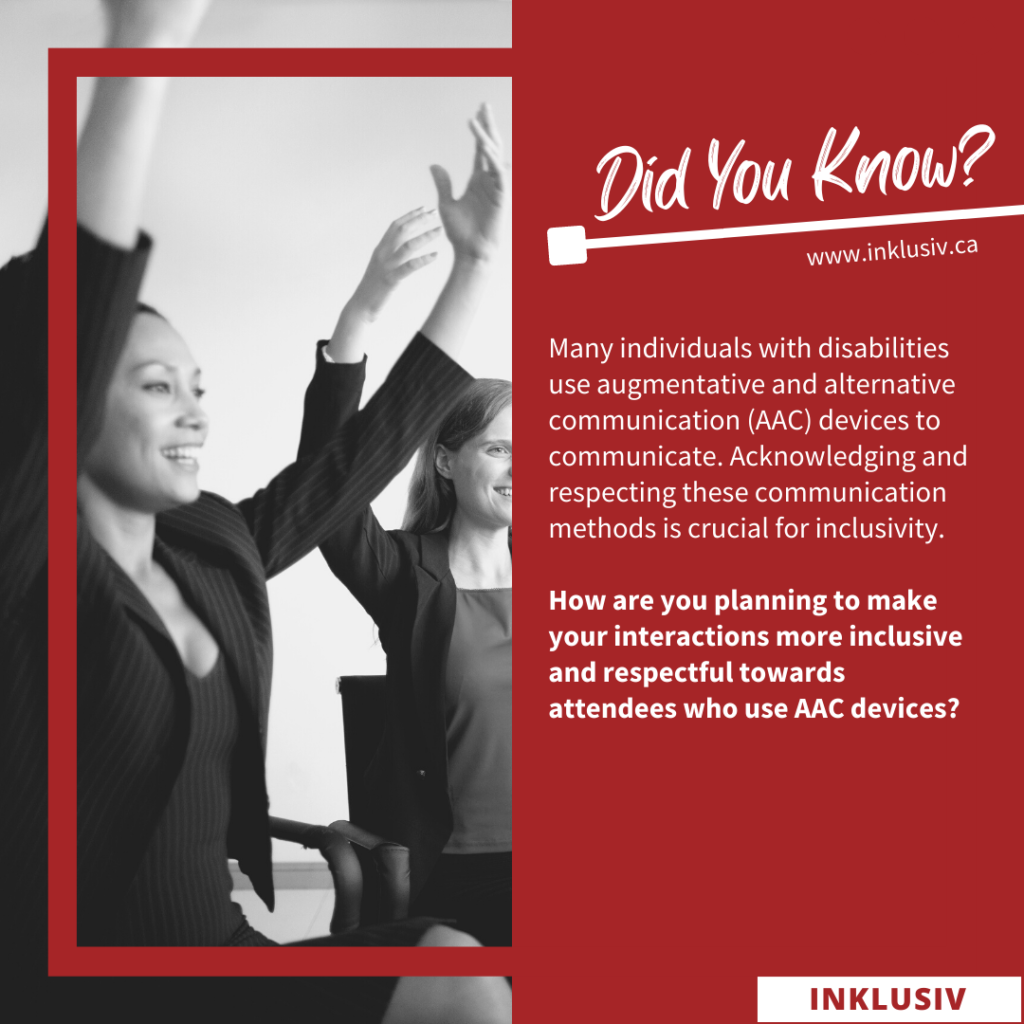

Many individuals with disabilities use augmentative and alternative communication (AAC) devices to communicate. Acknowledging and respecting these communication methods is crucial for inclusivity. How are you planning to make your interactions more inclusive and respectful towards attendees who use AAC devices?
More details about Did You Know… #068